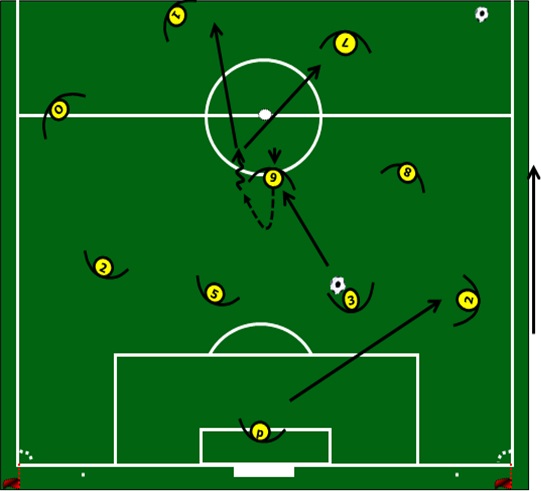The player must prioritize the ball game in depth (pass), or if applicable in progression (driving). In the event that you receive the ball with your back to the opposing goal, the priority will be to turn. The holder must pass the ball as a priority objective when there is a deep partner (vertical or diagonal) in a position to receive it with an advantage (if unchecked and the appropriate collective structure is manifested that allows him to continue with the progression/completion).
|
Graphic

Considerations
These "priorities in the holder's game" are the decisions that the holder must prioritize in relation to his game with the ball, although at all times he is free to decide the action he sees most convenient in each situation.
A correct decision will reduce the mistakes that are made when deciding between passing or progressing, which at the level of the collective game will reduce the number of losses of the ball.
The decision between passing or progressing must be "taken" before or during the execution of the receipt of the ball, so that in no case, to make this decision, the player has to stop the ball.
The holder's teammates, especially those ahead, must manifest themselves and be in a clear position to receive the ball (depth, search for the pass line,...), so that the holder can make the pass without any doubt.
When we talk about progression we include in the driving of the holder the actions of the dribble and the wall. When we talk about passing, we mean the execution of:
- A pass (from any perspective).
- A center or finisher when in the end zone.
When we have a player of a high technical level (security of not losing the ball in a 1:1) it is interesting to rush possession to:
- Create larger free spaces for colleagues.
- More definitely provoke the defensive action of the opposite towards the area of the ball ("fix"), which will allow a better use of the created free spaces.
- Cause the possibility of overflowing the other way around in a 1:1 with progression to the end zones.
- Allow the progression of all players in their line (while the holder progresses with the ball "controlled"), which will cause a more favorable situation than a direct in-depth pass (better and more appropriate occupation of the "Finish zones" in the Completion sub-phase).
In each competition unit in its offensive phase, the ultimate goal is to reach the completion zone with finishing options, but ensuring that during the process the ball will not be lost.
The holder should not be in a hurry for the ball to reach the end zone, but it is preferable to guarantee possession of the ball, which will cause:
- Increased number of arrivals in that end zone.
- Longer possession time.
- Lower defensive risks.
- Greater psychological wear and tear to the contrary, as a result of "running behind the ball".
Aimed at
Holder's game.
Training Goals
Help the holder decide the optimal action in the shortest possible time (execution speed)
Video
VIDEO FUB23c1: Game in progression/depth CORRECT MANIFESTATION 1
VIDEO FUB23c2: Game in progression/depth CORRECT MANIFESTATION 2
VIDEO FUB23c3: Game in progression/depth CORRECT MANIFESTATION 3
VIDEO FUB23i: Game in progression/depth INCORRECT MANIFESTATION
